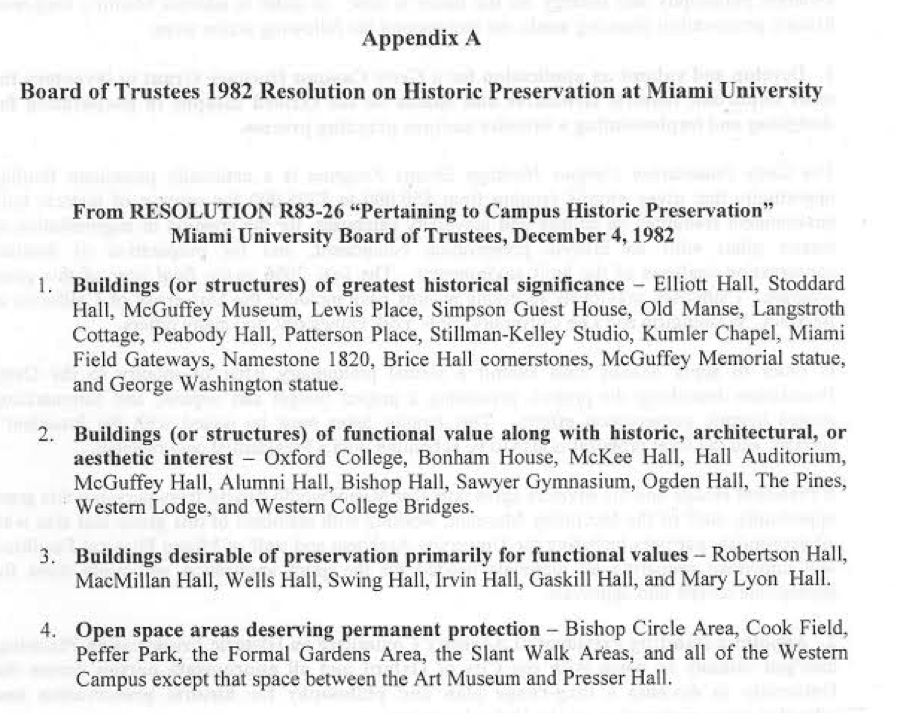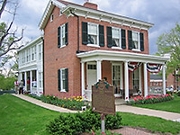
The Bishop Woods at Miami University
Natural Features
For many Miamians, Bishop Woods is iconic. It is seen, literally and figuratively, as the gateway to the University and its history is inextricably intertwined with that of the University.
The woods is the last remnant on the Oxford Campus of a vast tract of forest that existed when Miami was founded in 1809.
A five-member committee, appointed by the original Board of Trustees to select a one-mile square tract for the new college town of Oxford, hacked their way through a roadless wilderness, finally stopping on at a hill overlooking Four Mile Creek. This hillside site, chosen March 29, 1810, was to become the home of the new college (Havighurst, The Miami Years).
What they saw from that hilltop in 1810 is not unlike what one sees today in Bishop Woods, according to Dr. Orie Loucks, who served as Ohio Eminent Scholar of Applied Ecosystem Studies prior to his retirement and who has devoted much of his five-decade career to the study of forests.
According to him, several of Bishop Woods’ towering 100-foot plus bur oak and white oaks are 350 years old and were mature trees long before Miami welcomed its first students. More importantly, Bishop Woods continues to have a mix of trees of various ages, a mix typical of the historical forests of southwest Ohio.
Bishop Woods today is an all-age forest, and it was undoubtedly an all-age forest 200 years ago. We know that the trees in an old-growth forest die at a constant fraction, so that over the more than 200 years of Miami’s existence the oldest trees in Bishop Woods have died or blown down. So the question is not necessarily how old the oldest tree is, but is the age distribution and size distribution about the same as it was in 1809 (Loucks).
According to Loucks, Bishop Woods with its stand of trees of all age classes, from mature to seedlings, is representative of that original forest. One major difference, however, is the influx of invasive non-native species, including Amur honeysuckle (Lonicera maackii), winter creeper (Euonymus fortunei), burning bush (Euonymus alatus), garlic mustard (Alliaria petiolata), and others.
A two-decade effort organized by John (Jack) Keegan, Greenhouse Manager and Botany Instructor, has greatly reduced the presence and impact of invasive species. At least once a year and sometimes more, Keegan has coordinated with Miami’s grounds crew and recruited students, including botany students, fraternity brothers, and Glee Club members to assist in removing Amur honeysuckle, garlic mustard, and other exotics. Faculty members and even the children of faculty members have taken part in this ongoing eradication effort. On occasion, the work project has also included planting native species. As a result, the number of non-native plants today is a tiny fraction of what it would be without Keegan’s leadership and commitment, according to plant ecologist Dr. David Gorchov, Professor of Biology and president of the Ohio Invasive Plants Council.
The woods include species of native trees commonly found in the temperate deciduous forest landscape that characterizes the Oxford area. Included are white oaks (Quercus alba), red oaks (Quercus rubra), sugar maples (Acer saccharum), black maples (Acer nigrum), box elder (Acer negundo), green ash (Fraxinus pennsylvanica), white ash (Fraxinus Americana), blue ash (Fraxinus quadrangulata), beech (Fagus grandifolia), buckeye (Aesculus glabra), bitternut hickory (Carya cordiformis), shellbark hickory (Carya laciniosa), black walnuts (Juglans nigra), and redbud (Cercis canadensis) (Vincent email, 2013).
A variety of non-native trees can also be found in the woods including many invasive callery pears (Pyrus calleryana), several invasive Malus species (apples and crabapples). On the east end, there are non-native hedge apples (Maclura pomifera). There is a scotch pine on the north edge. There are also several white mulberries (Morus alba) (Vincent email, 2013).
Native spring wildflowers carpet the forest floor including Dutchman’s breeches (Dicentra cucullaria), May apple (Podophyllum peltatum), Sessile trillium (Trillium sessile), common blue violet (Viola sororia), cut-leaf toothwort (Cardamine concatenata), white trout lily (Erythronium albidum), purple cress (Cardamine douglasii) and Virginia spring beauty (Claytonia virginica) (List from student surveys carried out in Dr. Nancy Smith-Huerta’s Botany 204 class in the spring of 2009 as reported in an honors thesis by Jillian Hertzberg ‘11). Two of the rarer species are nodding rattlesnake root (Prenanthes crepidinea) and false mermaid-weed (Floerkea proserpinacoides) (Eshbaugh email, 2013).
History*
*Researched and written by Steve Gordon, Administrator, McGuffey Museum, December 2013.
Early maps of Oxford and Miami show the “University Square” occupying the western side of the 54-acre rectangle bounded by present-day High Street, Patterson Avenue, Spring Street and S. Campus Avenue. The eastern portion of the rectangle was identified as the “College Grove,” which with the opening of “New Miami” in 1885 became known as the “Lower Campus.”
Images of the campus prior to the Civil War depict Old Main in the foreground with North and South Dorms in the background. Behind the dorms to the east stood undeveloped woods (Miami University, 1838; ca. 1858). Charles Temple described Oxford’s outlots (parcels south of Spring Street) in the early 1820s as “covered with dense forest, affording plenty of small game” (Johnson, p. 3). During the “Old Miami” era (1809-1873), students housed in North and South dorms [Elliott and Stoddard] and in Oxford’s boarding houses likely scavenged the area for wood to fuel fireplaces and wood stoves. While a student at Miami, T. C. Hibbett noted in his diary of spending time chopping wood for his stove (Hibbett, Jan. –March 1852; Nov. 1852). At that time, Miami’s campus consisted of three buildings, and it seems unlikely there was much use for the College Grove other than for warm weather gatherings, evening walks, and as a convenient public source for firewood.
The College Grove was a favorite place for students to take strolls and contemplate nature. Benjamin Chidlaw, Miami Class of 1833, recalled he “often took a walk in the ‘pleasant grove behind the College,’ just as the king of day was rising, and spreading its golden beams on the face of nature” (Paddy’s Run, p. 3). On June 28, 1854, T. C. Hibbett wrote in his diary, “We, the Union Literary Society, had our address delivered by Thomas Williams, Jr., of Pittsburgh, Pa., in the grove of the college campus. A very large audience was present, and as the address was very good, strict attention was paid” (Pratt, pp. 127-128).
After 1885, during the formative period of the “New Miami” years, the University appears to have made a more concerted attempt to keep a portion of the woods open for alumni events and other gatherings. In June 1893, The Miami Student reported, “The Alumni Association was held in the Grove” (Miami Student). A winter photo taken by Will McCord ca. 1894 indicates open woods in the area of Lower Campus east and southeast of South Dorm. The notion of a pristine, untrammeled virgin woods had long since past.
The earliest known photos taken by Frank Snyder ca. 1905-1912 show Lower Campus as dense woods with mature hardwood canopy and understory. A photo featured in With Miami Men depicts students walking along a gravel path flanked by tall trees and lush undergrowth (With Miami Men, 1916). During this period, some attempts were made to control the “wild” nature of Lower Campus. The 1915-16 “Report of Buildings and Grounds” stated, “The lower campus has not been kept in good condition the past three years. Undergrowth has purposely been allowed to grow to protect young trees. The growth is very rank now and an effort should be made the coming summer to clear at least one-third of the ground” (Annual Report, 1915-16, p. 188). If grounds maintenance was sporadic, it appears the University endeavored to keep some of the forest floor open and there were maintained paths through the woods. Gravel and herringbone brick paths provided pedestrian access through the woods. The herringbone brick walk seen in the Snyder photos likely was the main walk that connected Patterson Avenue and central campus, and was the principal walkway used by Western College women.
A survey conducted in 1912 described Miami’s Lower Campus as a 28-acre, Class B woodlot, comprised of
Old stand oak, maple, beech, and ash, with walnut and some hickory. Young elm and ash with some walnut. (The young growth has mostly been destroyed, there being large plots of grass-sod with no young growth). (Woodlot Survey, p. 27).
Harvey Hiestand’s campus map drawn in 1920 shows the “Campus Forest” west of Patterson Avenue. The satirical “Campustry” drawing ca. 1932-1939 features a squirrel in the Lower Campus. Aerial photos taken in July 1938 show Lower Campus as established woods. University maps indicate two primary paths provided access into and through Lower Campus. One path extended roughly east to west and allowed access from Patterson Avenue into the main campus. Another path followed a more diagonal route roughly from present-day Shideler Hall, connecting to the main path. This latter path is shown in Frank Snyder’s photo taken of the Lower Campus in 1906.
Lower Campus held a special place in the hearts and minds of many Miamians, and photos were regularly featured in the Miami Yearbooks (Recensio, 1907, p. 59; 1909, p. 36; 1910, p. 82). A whimsical map of Lower Campus drawn in 1910 included a grove, lover’s seat, and tree (Recensio, p. 254). Near the end of World War I, Miami students in France under a grove of trees found themselves thinking of home, “wondering if the wind still moved through the high branches of the trees of the lower campus as it used to in the summers that are past” (“Talk of Miami,” p. 2). Spring marked the budding of college romances, but even quiet lovers could not escape the watchful eyes of the “Romantic Ghost:”
A warm soothing breeze rustled a few leaves as it drifted thought the lower campus.
Couples sauntered arm in arm along the winding paths, sheltered by the giant trees
And the Industrial Education Building...Quietly, a mysterious figure materialized
above one of the paths....The few visitors to the area did not notice the stranger. He
stood by the path and watched them pass arm in arm, or he walked along with some,
smiling and laughing with them. He was glad, for the cold winter snows and winds
had fled, and now he would rule again over “lower” campus. Romance had
returned! (“Romantic Ghost Comes to Haunt Lower Campus,” p. 2).
Given the serenity and solitude associated with Lower Campus, it seemed a fitting location for Miami’s first artist-in-residence. In August 1920, President Hughes invited Percy MacKaye, a nationally know dramatist, to hold a Fellowship in Creative Arts. The University agreed to construct a small, single story frame cottage, or “artist shack” in the Lower Campus near present-day Upham Hall. By October 1920, MacKaye’s “little house” was practically complete. The Student noted, “Hidden away among the trees, the little cabin seems to be a part of the wood which surrounds it. . . . It is expected that the students of Miami who are interested in literary work, will be permitted to gather about the great fireplace on winter evenings” (Student, Oct. 29, 1920, p. 1).
In April 1921, MacKaye invited the literary societies to his studio for an evening reading. Hewitt Vinnedge, a member of the Erodelphians, recalled the event:
By 9 o’clock . . . we had all arrived, including Mr. Torrence and several members of Alethanai, the women’s literary society. Mr. MacKaye was seated by a lamp near the fireplace. . . . Until almost Midnight Mr. MacKaye read to us. All who have heard him know with what emotional play and dramatic effect he reads. We were fascinated, electrified, almost rendered speechless as we heard that tragic tale . . . . It was exceedingly late when we . . . left the shack making our way through the woods . . . . All the girls’ dormitory rules had been broken that night, but it mattered not. They felt, as we all did, that they were among the chosen few to hear the first reading of the greatest narrative poem yet written by an American (Miami University 1809-2009, p. 160).
Lower Campus inspired MacKaye to pen the poem “The Trees of Miami,” a verse of which is inscribed on the north pavilion of Upham Hall, just a few hundred feet west of the site of MacKaye’s rustic cabin. The dense woods proved idyllic for the young poet:
“Secluded in the quiet of a great grove, my studio is an admirable place of work, and has already afforded opportunity, during some months, for a kind of uninterrupted thought and creative experiment which the overcrowded hours of many former winters have precluded,” MacKaye wrote. “But it has also provided occasion for a kind of informal interchange of ideas and friendship with both faculty and students, very stimulating and delightful in itself and conducive toward enlarged horizons for the social as well as the art meanings of my “fellowship” privileges.” [Percy MacKaye, The Forum. June 1921].
Miami awarded MacKaye an honorary degree at its 1924 commencement, and he maintained cordial relations with Hughes. MacKaye’s Lower Campus studio, dubbed “The Poet’s Shack,” was abandoned after his residency. It was razed in 1934 (Miami University 1809-2009, 160).
The period from 1940-1966 saw Miami’s enrollment rise from 4,300 to 10,500 students. With growing demand for classroom and office space, Upham Hall’s center section was constructed in 1949, with north and south wings added in 1950 and 1965. The two primary paths through Lower Campus remained largely intact (Campus Map, 1947).
In the late 1950s, as the University prepared for its Sesquicentennial, Arthur F. Conrad, chief of grounds, proposed a circular drive east of Upham Hall beginning and ending in Patterson Avenue with two ornamental gates at the approaches and the renaming of the woods to be in the future known as “The Bishop Woods.” This would allow buildings to be built on High and Spring with the woods between them. According to Cal Conrad, “John [President Millett] approached the Bishop heirs about funding the construction to honor the former president”(Conrad, 2013).
In June 1960, the Bishop Memorial Gates were dedicated on Patterson Avenue “at the foot of the Lower Campus wood” (Oxford Press, May 26, 1960). Largely unknown is the fact the Gates were built as a memorial to Robert Hamilton Bishop, Jr., grandson of Miami’s first president and member of Miami’s Class of 1903. According to Robert Schmidt, University Archivist, the Bishop heirs intended the woods to remain in a natural state (Schmidt). President Millett may have interpreted their wishes differently. In a letter to Mrs. Bishop, Millett stated:
You’ll be glad to know that the Bishop Memorial Gates are all finished and look most attractive. Unfortunately, the Gates do not have the setting that they really need to show them off well. I’m afraid our landscape work will not be finished by June either. . . . I can promise you that by next September the whole area will look quite different from the way it does today (Millett to Bishop, Jan. 18, 1960).
The Neo-Georgian style gates formalized the eastern entrance to campus and symbolically marked the end of the former campus entrance along South Campus Avenue west of old Hepburn Hall. The automobile age had arrived at Miami. Vehicular access to Upham Hall and Lower Campus was complete. The University instituted a more systematic maintenance program for the Lower Campus. The grounds around the trees were mowed, suppressing the growth of tree seedlings and other forest plants. Soon, new academic buildings would rise on the north and south sides of Lower Campus. Culler and Shideler Halls were constructed on the south side of Lower Campus in 1961 and 1967, respectively, and in 1970 Hughes Laboratories consumed much of the north side of the Lower Campus woods. The U-Shaped vestige of Lower Campus, unofficially known as Bishop Woods, was now framed by academic buildings, and provided the woods with an ordered, more institutional sense of enclosure.
Although the space itself was clearly preserved as a woodland vestige, it was not left in a natural state. Photos taken during the 1970s and early 1980s show an open floor with several conifers planted along the perimeter (Gordon; Miami Archives; PFD). During the period from 1965-1986, faculty, staff and students experienced similar recollections of Bishop Woods. Valerie Elliott and Steve Gordon, students during the early 1970s, recalled the woods as a treed, open space with visibility through the woods. W. Hardy Eshbaugh, Professor of Botany from 1967-1998, used the woods as a nearby field laboratory. Rather than carefully manicured, he remembers the space was occasionally mowed:
When I started teaching there was little honeysuckle around and no Russian olive. The woods was open and periodically it was mowed. The Department of Botany objected to it being mowed because it was the only place we could quickly take a class to see some plants in a "natural" setting. It was our living laboratory. I think it was periodically mowed until the Paul Pearson decree went into effect (Eshbaugh, 2013).
The level of maintenance varied over the years. Donald Kaufman, Professor of Zoology from 1973-2003 and currently Director of the Hefner Zoology Museum describes his early observations of Bishop Woods:
From 73-79, the forest floor was pretty much left alone. The reason you could see through was that we didn't have all those invasives. Then we went through a period of manicured mowing. You could see the grasses, but I don't remember that the grounds crew seeded the area or anything. The reason I can remember this so clearly is that we used to joke about Miami's propensity to cut grass! Everything had to look neat and trim, even the University's only campus "wild place"!
Then we went into the period of leaving Bishop Woods alone entirely. It wasn't just for the regrowth of wildflowers, though. It was to prevent the continuing noticeable compaction that was occurring around/above the tree roots. It was thought that the compaction was leading to the decline of the large trees (Kaufman).
A student during the late 60s and early 70s, Steve Snyder, along with Curtis Ellison, Professor of History & American Studies who arrived in 1970, remember Bishop Woods as exhibiting much the same appearance. The woods were maintained but not to the level of the campus quadrangles. Richard Nault, former director of Student Life, said President Pearson, himself a biologist, was a keen observer of the campus grounds. Pearson, explained Nault, wanted to protect the root zones from compaction and pedestrian encroachment. This was a critical aspect of his decision to restore Bishop Woods (Snyder, Ellison, Nault, 2013).
The presidency of Paul Pearson ushered in a new era of natural areas awareness and campus preservation efforts. In December 1982, Miami’s Board of Trustees resolved that the Bishop Circle Area is “deserving of permanent protection” (Resolution R83-26). In 1986, mowing of Bishop Woods was suspended and an “experimental project” began to allow the area to “revert” to a natural state (Norman, 2013).
Today, Bishop Woods stands in vivid contrast to the neatly manicured, ordered and largely artificial landscape that defines much of Miami’s Oxford campus. Here, perhaps more than any space in the central campus, visitors can sense the very earliest natural images of Old Miami. Bishop Woods, secluded and almost primordial in feeling, stands in stark contrast to the modern, synthetic turf that covers much of the brightly illuminated Cook Field, and the imposing silhouette of the new Armstrong Student Center.
Academic Uses and Alumni Memories
Bishop Woods is a natural oasis on a campus that has increased from its original 20 students (Havighurst, The Miami Years) to almost 18,000 students (Wagner, 2013). Its existence in the central campus provides opportunities for learning, relaxation, and connecting with nature. Students who walk on its paths or warm themselves by the fireplace at the nearby Armstrong Student Center may be unaware that the first Miami students foraged for firewood to heat their rooms in this very place.
But even if that far-distant student lifestyle has been forgotten, decades of students, faculty, and staff cherish Bishop Woods for providing a bit of wildness amidst a modern University. Within a few feet of high-tech classrooms and scientific laboratories, visitors can find not only solitude, but may get a glimpse of flying squirrels, pileated woodpeckers, and Miami’s mascot, the red-tailed hawk.
Cal Conrad ‘58 remembers attending botany classes in the woods. He also recalls Miami’s goal posts ending up there after a football victory. In 2004, Conrad (the son of Arthur Conrad, Miami's Director of Grounds from 1937-72) became an outspoken critic of a proposal to put the new business school building on the site. A letter he wrote to the Oxford Press was also quoted in the Commentary section of the Miami Report (The Miami Report, Sept. 9, 2004):
“A number of years ago Arthur Conrad, the director of grounds, was directed to exhume the remains of Dr. and Mrs. Robert Bishop from the grounds of the Ohio Military Institute in Cincinnati and rebury them at the end of the long walk in the Formal Gardens. In return for honoring this request from the Bishop family Miami received the funds to erect the Bishop gates and create a circular drive to enclose the virgin wooded parcel that is known as the Bishop Woods. It was represented by the Miami administration that this would for all time commemorate Dr. Bishop's service as Miami's President from 1824 until 1841.
I believe this parcel represents the only stand of virgin forest within the city of Oxford or at least within the original mile square. It is an irreplaceable treasure. It is sad when a 200- or 300-year-old tree is removed but to unnecessarily wipe out an entire stand of ancient trees should be unacceptable.
Proposals by the current president and administration of Miami University apparently indicate an intention to substantially destroy this wooded parcel replacing it with brick and mortar in the form of a new school of business. The loss of this irreplaceable forest would be a tragedy for both Miami University and the city of Oxford. The Miami proposal brings to question the integrity of a university that accepts money in one generation, makes promises and then reverses them at some future convenient moment.
I believe it is time for 'old Miami' to speak out to 'new Miami' to assure preservation of this lovely area for all time and to honor the commitment made by the university by encouraging the placement of the new school of business at some other equally satisfactory location leaving the Bishop Woods, as promised by Miami, for the pleasure and enjoyment of all future generations of Miamians and towns people.“
The Farmer School of Business ultimately was built at the intersection of Patterson Avenue and High Street, saving the woods from destruction.
Nancy Hanger ’68 lived in Dorsey Hall her freshman year, which meant walking through the woods most mornings to get to Upham Hall.
I would cross the road diagonally, as we all did, and head up the cinder walk. I walked through the trees in the rain, the snow, the fog and the beautiful days of spring and fall. The walk always brought a sense of peace amidst the often unsettled life of a freshman. I railed at my alma mater when Hughes Hall was built through my woods and my cinder path, but fortunately some trees survived, as did my memories. (Hanger, 2013).
Lorna Moehle Wallick ’73 remembers being entranced by the woods as she walked to her daily classes in Upham Hall, contemplating how appropriate the words of Percy MacKaye inscribed on Upham Hall were:
“Trees of Miami, beautiful trees.
Truth, remembrance, youth--
Of these you brood
In your ancient reveries.”
Winifred Pearson often strolled through the woods with her husband, the late Dr. Paul Pearson, Miami’s president from 1981-1992. He felt the woods was important to both Miami’s history and the attractiveness and appearance of campus, she said, and took steps to preserve it for future generations.
Bishop Woods has been in continual use as a living laboratory for decades by Miami botanists and other faculty members. The examples cited in this report represent merely a sampling of the academic uses of the woods.
Dr. W. Hardy Eshbaugh, Professor of Botany from 1967-1998, used Bishop Woods extensively while teaching Dendrology and Plant Taxonomy courses. The Osage orange hedge along Patterson Avenue (U.S. 27), which was removed the summer of 2013, provided Eshbaugh with an opportunity to determine if students understood that a single species could have different forms. His quizzes frequently asked students to identify Osage orange trees and then to identify the shrub version. “They usually missed it. I was known to give Osage orange two or three times on a quiz. Students just couldn’t believe a professor would do this.”
Botanist Dr. Hank Stevens, Associate Professor of Biology, has used Bishop Woods for his Ecology of North America course each fall for the past 10 years and for Talawanda Science Week for the past four years.
Students learn about plant identification, community structure, and the relationship between a sample with a particular history to the whole, which is the deciduous forest biome (Stevens).
Dr. David Gorchov, Professor of Biology, has also used Bishop Woods as an outdoor laboratory. One of the students he mentored, Jillian Hertzberg ‘11, who now works as a program assistant at Earthjustice in Washington, D.C., did her honors thesis on Bishop Woods.
The academic usefulness of Bishop Woods is well documented.
But it may be the link that Bishop Woods provides to Miami’s past that is its most crucial asset. Here, more than any other space in the central campus, visitors can sense Old Miami’s pioneer past. Bishop Woods, secluded and natural, provides a contrast to the mowed lawns and red brick buildings of a modern university that has achieved national prominence.
It is a site that demonstrates that change and continuity co-exist at Miami.
Attachments
Board of Trustee Resolutions and Miscellaneous
Background: Bishop Woods is approximately 3 acres. In 1986 the decision by the Board of Trustees was to let this area of big trees, some as old as 150 years, revert back to a woods. With its underbrush, wildflowers and young trees of differing heights, it provides a natural contrast to Miami's neatly manicured campus of lawns, paved walkways and red brick buildings. Education: Bishop Woods is used as a natural laboratory for Miami's zoology, botany, and other classes.
Through Miami University’s Center for Environmental Education, Natural History and Conservation, and Partnership with Talawanda School District, several thousand public school students each year use Bishop Woods for study and research.
Today: Bishop Woods is a green haven of peace, beauty and tranquility, in the midst of buildings and mowed grounds, where nature can easily be observed, experienced, studied and appreciated.
The Problem: It may appear to the casual observer that Bishop Woods is in neglect and therefore unimportant to the University as it progresses in its journey of succession. Nothing could be further from the truth.
The Goal: In partnership with Miami University Natural Areas, Botany and Grounds a plan has been developed for the enhancement and maintenance of Bishop Woods as an important resource for education, research and quiet solitude.
The Plan:
- Develop walking trails to selected areas for study.
- Build a nature garden to attract birds and butterflies.
- Add bird-nesting boxes.
- Add additional species of native wildflowers, particularly those with attractive flowers or decreasing in abundance elsewhere in our region due to overgrazing by deer.
- Use as a source of saplings of native trees species desired for planting elsewhere in Natural Areas or Grounds. This would only be done for species deemed to be so abundant in the Woods that removal would not jeopardize their representation.
- Add rocks with fossils and glacial erratics.
- Add benches for rest and reflection.
- Add a kiosk at the top of the horseshoe circle to explain the story, purpose, and uses of Bishop Woods.
- Add discreet educational signage at key locations
- Remove invasive plant species and unsightly debris. However, snags and some large woody debris would be left in place as a habitat for animals and contribute to nutrient cycling.
- Conduct inventories of species as needed to inform other objectives of the Plan.
From: "Seibert, John Kelly Mr." <seiberjk@muohio.edu>
Date: February 3, 2009 1:22:42 PM EST
To: "Reid, James" reidje@mac.com (Field Manager of Miami Natural Areas)
Subject: Bishop Woods Update
Jim, The Campus Planning Committee unanimously approved the Bishop Woods management plan this morning.
A few notes from the meeting:
They asked if additional walking trails are added to consider views / vistas through the Woods to improve security concerns. They asked to consider curb cuts and ADA / wheelchair access on trails – Five foot wide paved trails would meet ADA and ANSI requirements in the Woods.
They did indeed concur that campus standard signage and benches would be required.
They asked that the new Student Center site plan – when done – takes into account how it borders and how access to / from Bishop Woods to the north east corner of the building would be integrated.
They asked that access to the Woods be kept open during maintenance / improvement projects as much as possible.
I have a separate meeting with Bob Keller to discuss funding for signs and benches as this committee does not provide funding for projects, only campus planning oversight and approvals.
What can I do to help you advance the other improvement planned?
John
John K. Seibert
Senior Project Manager
121 Cole Service Building
Miami University Physical Facilities Department
Division of Planning & Construction
Oxford, OH 45056 p: 513-529-2354
1852 Outlot Map
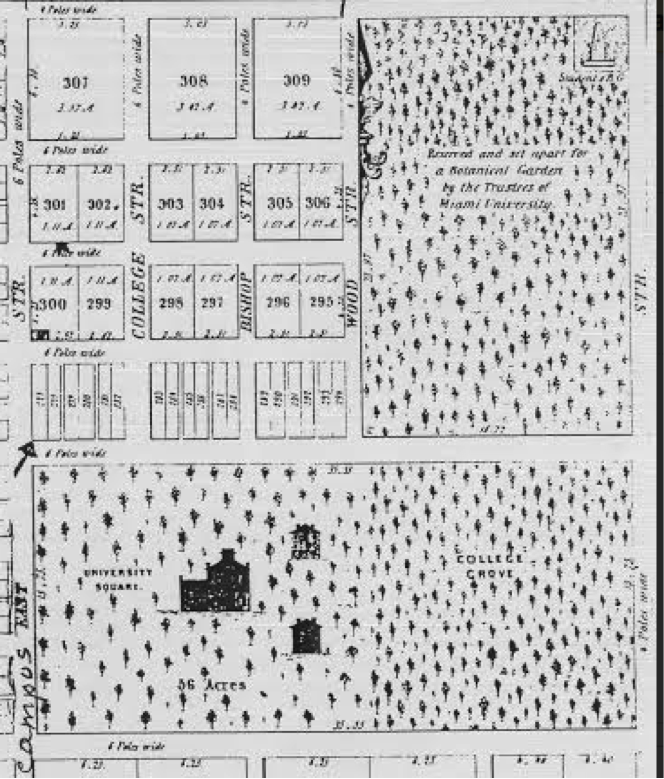
1875 Campus View
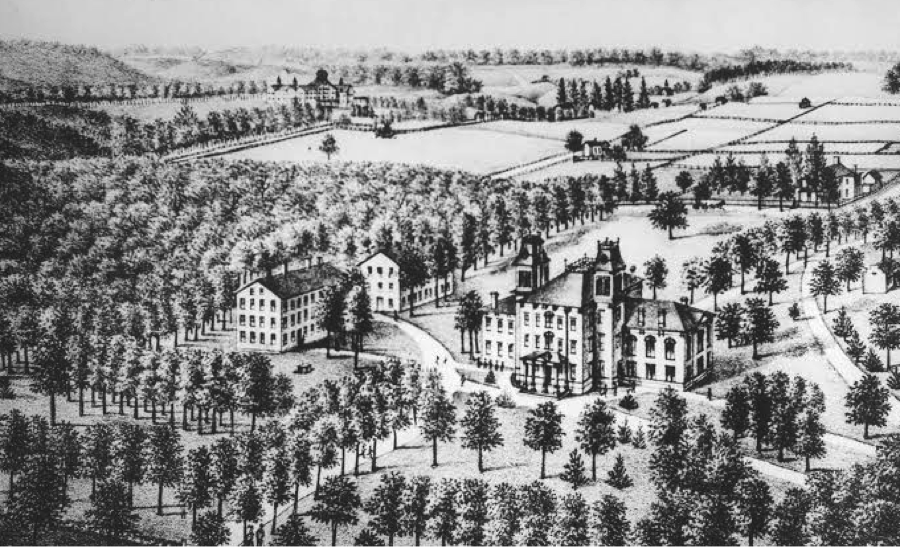
Lower Campus Photos
1906 Lower Campus
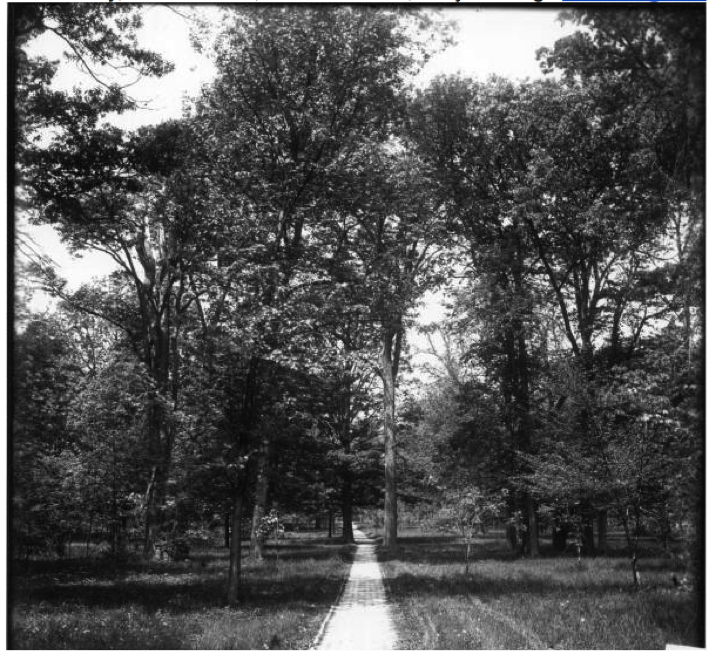
1906 Lower Campus with Men Walking
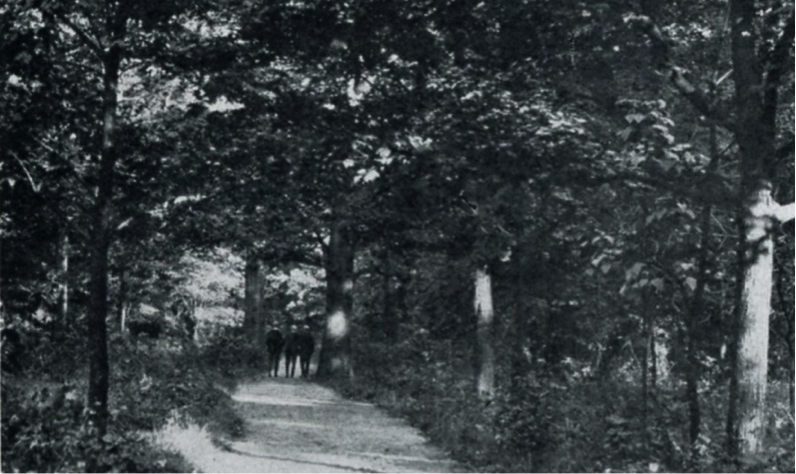
Poet's Shack
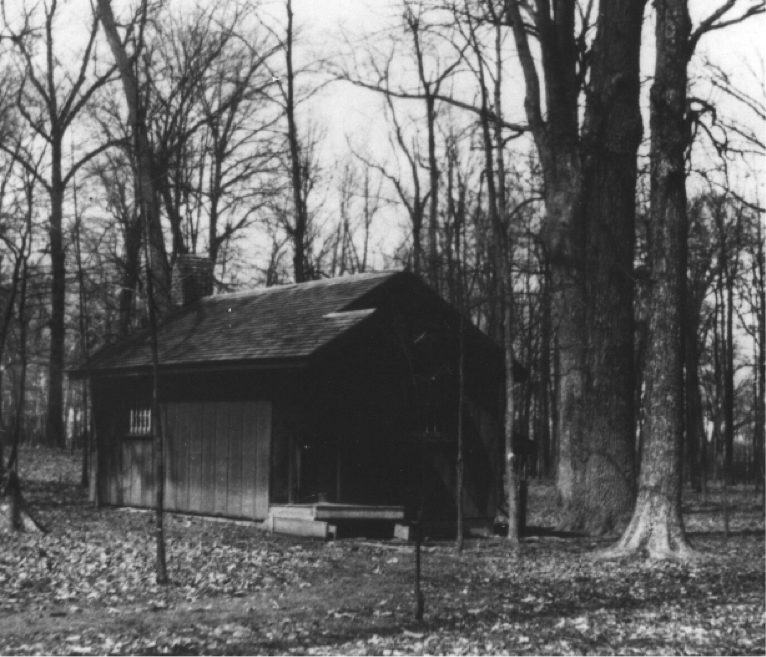
Lower Campus Postcard, The Fork
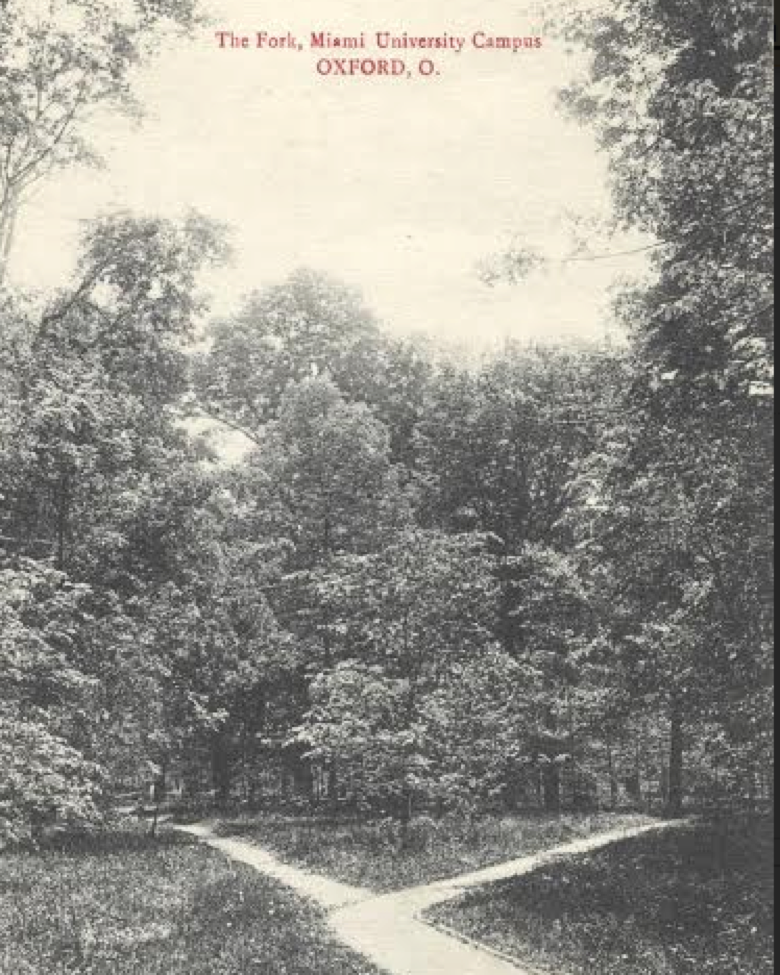
1962 Bishop Gates
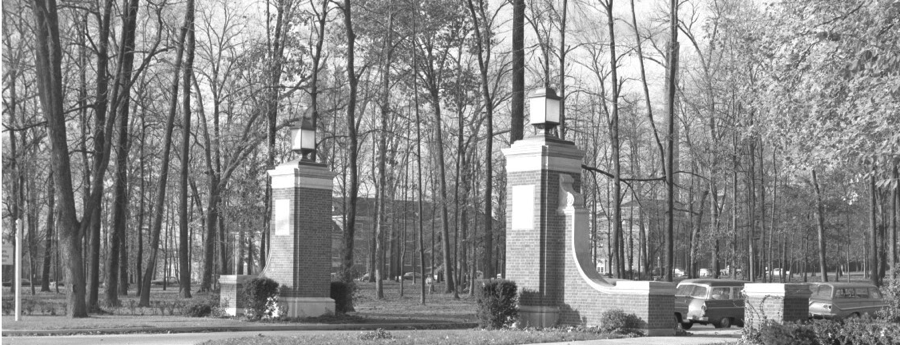
Early 1980's view of Hughes Hall
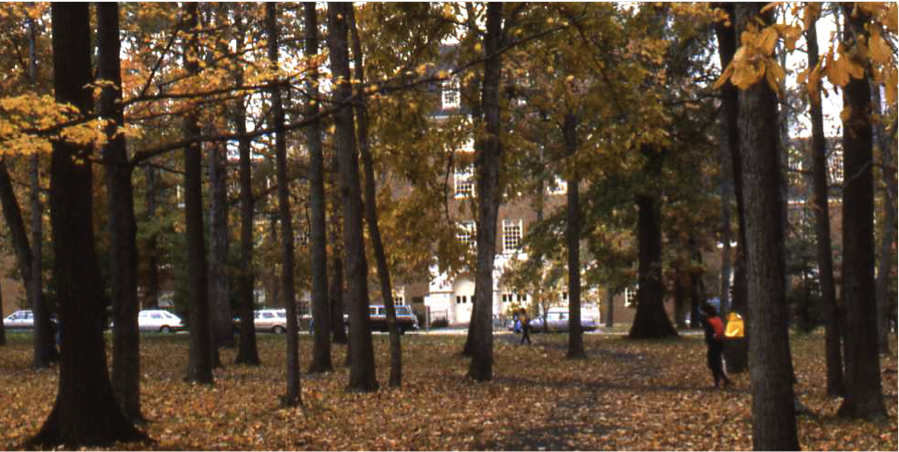
1986 Signage
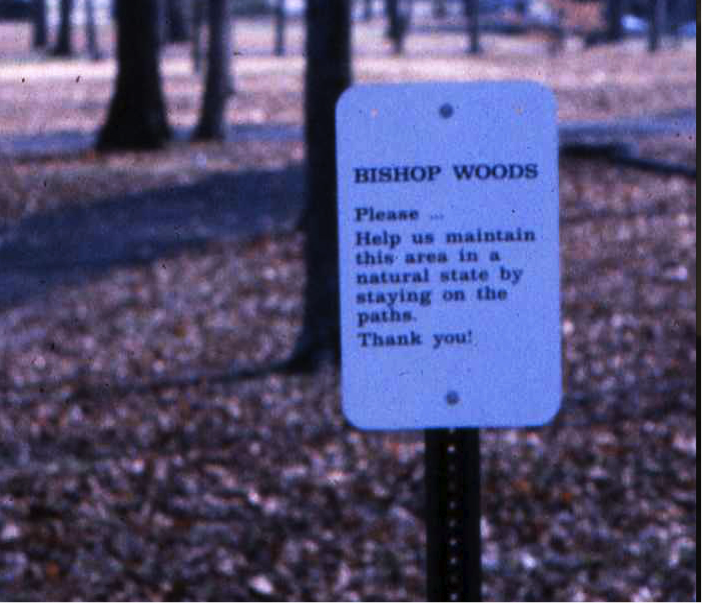
Snow Scene [Keegan, circa 2011]
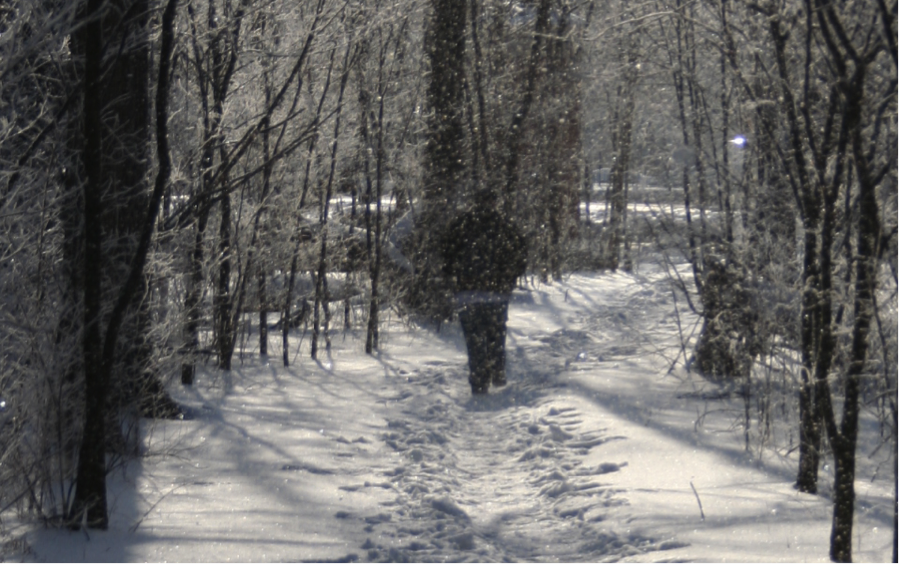
Carpet of dogtooth violets [Keegan, circa 2011]
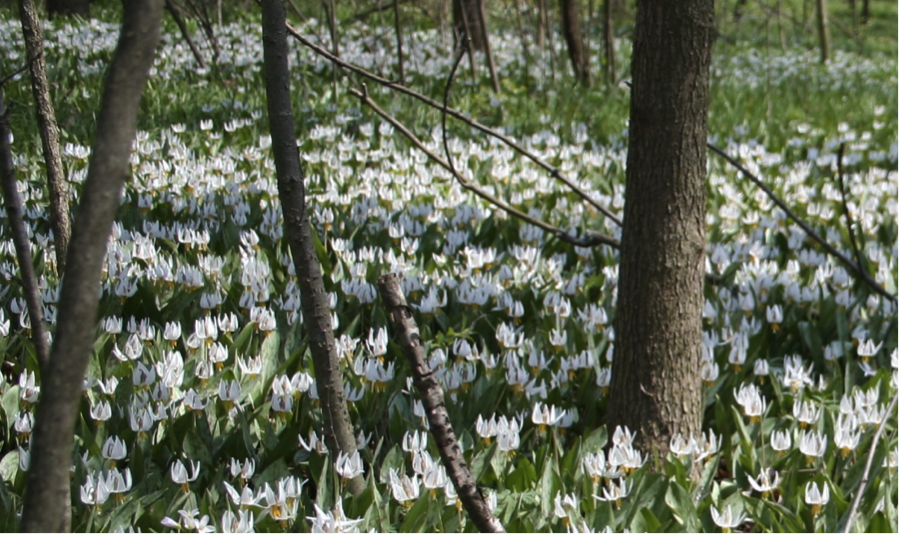
2008, Removing Invasives [Keegan]
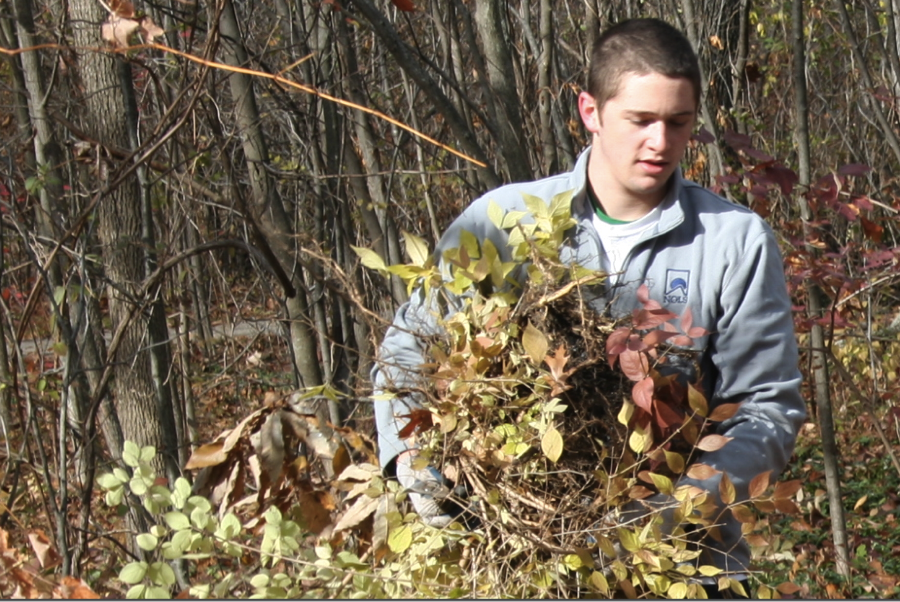
Sources
“Bishop Descendants to Come for Dedication of Gateway.” Oxford Press (May 26, 1960): 2.
Conrad, Cal. Email Communication. 22 November 2013 and 17 December, 2013.
Ellison, Curtis. Email Communication. 4 December 2013.
Ellison, Curtis W., ed. Miami University 1809-2009: Bicentennial Perspectives. Athens: Ohio University Press, 2009.
Eshbaugh, Hardy W. Email Communication. 2 December 2013 and 11 December 2013.
Gorchov, David. Email Communication. 22 November 2013, 20 December 2013.
Green, Nancy. Email Communication. 9 December 2013.
Havighurst, Walter. The Miami Years. G.P. Putnam’s Sons, New York, 1958.
Hertzberg, Jillian M. Investigating the Effects of the Invasive Euonymus fortunei On Populations of Native Species in an On Campus Forest and Assessing Campus Population Social Value in Developing a Protection Plan. Honors Thesis. Miami University, 2011.
Kaufman, Donald. Email Communication. 3 December 2013.
Johnson, Elizabeth, Ph. D. To Dwell With Fond Reflection: Families Who Lived In the McGuffey House, 1833-1958. Oxford: Miami University, 2009.
Kennedy, J. M. and Mollyneaux, W. J. Map of Oxford, Ohio. 1852.
Maxfield, David Briggs. Map of Miami University. 1947.
Letter from John D. Millett to Mrs. Robert H. Bishop. January 18, 1960. Miami Archives.
Loucks, Orie. Verbal Interview. 2 December 2013; Email Communication. 18 December, 2013.
The Miami Report, Commentary by Warren Mason, miamioh.edu/news/article/view/8676 September 9, 2004
The Miami Student.
Nault, Richard. Verbal Recollection. December 8, 2013.
Norman, Richard. “Response to Bishop Woods Commentaries.” Miami Report (September 2004):
O’Byrne, Frank. A Woodlot Survey in Oxford Township, Butler County, Ohio. Oxford: Miami University, July 1912.
“Oxford From an Air Ship.” The Recensio. 1910.
Paddy’s Run Papers (May 1895).
Pearson, Winifred. Telephone Conversation. December 9, 2013.
“Percy Mackaye Now a Reality at Miami.” The Miami Student. October 29, 1920.
Pratt, William, ed. College Days at Old Miami: The Diary of T. C. Hibbett, 1851-1854. Oxford, Ohio: Miami University, 1984.
The Recensio. 1907-1910.
“Report of Buildings and Grounds.” Miami University Annual Report, 1915-16.
Resolution R83-26 “Pertaining to Campus Historic Preservation.” Miami University Board of Trustees, December 4, 1982.
“Romantic Ghost Comes to Haunt Lower Campus.” The Miami Student. March 31, 1939.
Schmidt, Robert. Telephone Conversation. December 5, 2013.
Snyder, Steve. Email Communication. 4 December 2013.
Stevens, Hank. Email Communication. 16 November 2013.
“Talk of Miami.” The Miami Student. October 18, 1918.
Wagner, Claire. Email Communication. 7 December 2013.
Wallick, Lorna. Telephone Conversation. 24 November 2013.
With Miami Men. Miami University, 1916.
Acknowledgements
Richard Costello, Physical Facilities Department.
Valerie E. Elliott, Head, Smith Library of Regional History.
Curtis W. Ellison, Ph.D., Director, Michael J. Colligan History Project.
David Gorchov, Ph.D., Professor of Biology.
John F. Keegan, Greenhouse Manager and Instructor, Biology Department.
Robert Schmidt, Ph.D., University Archivist.
Michael Smith, Physical Facilities Department.
Michael Vincent, Ph.D., Professor of Biology.
William Holmes McGuffey House and Museum
We aim to collect, preserve, interpret, and exhibit materials relating to the life of William Holmes McGuffey, the McGuffey Eclectic Reader series, the history of Miami University, and 19th-century domestic life and architecture of southwest Ohio.

Hours of Operation
Thursday - Saturday
1:00pm - 5:00pm
McGuffey House and Museum observes Miami University closings and other special events.
Summer Hours 2024
Thursday - Saturday 1:00 PM - 5:00 PM
Closed
Saturday, May 25 for Memorial Day
Thursday-Saturday July 4-6 Independence Day

